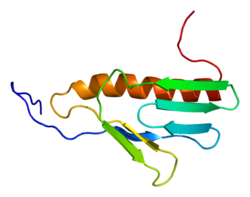60S ribosomal protein L9 is a protein that in humans is encoded by the RPL9 gene.[5][6][7]
Quick Facts RPL9, Available structures ...
| RPL9 |
|---|
 |
| Available structures |
|---|
| PDB | Ortholog search: PDBe RCSB |
|---|
| List of PDB id codes |
|---|
2CQL, 4UG0, 4V6X, 5AJ0, 3J92, 4UJC, 3J7P, 4UJE, 3J7Q, 3J7R, 4D67, 4UJD, 4V5Z, 4D5Y, 3J7O |
|
|
| Identifiers |
|---|
| Aliases | RPL9, L9, NPC-A-16, ribosomal protein L9 |
|---|
| External IDs | OMIM: 603686; MGI: 1298373; HomoloGene: 90855; GeneCards: RPL9; OMA:RPL9 - orthologs |
|---|
|
|
|
|
|
| Wikidata |
|
Close
Ribosomes, the organelles that catalyze protein synthesis, consist of a small 40S subunit and a large 60S subunit. Together these subunits are composed of 4 RNA species and approximately 80 structurally distinct proteins. This gene encodes a ribosomal protein that is a component of the 60S subunit. The protein belongs to the L6P family of ribosomal proteins. It is located in the cytoplasm. As is typical for genes encoding ribosomal proteins, there are multiple processed pseudogenes of this gene dispersed through the genome. Two alternatively spliced transcript variants encoding the same protein have been found for this gene.[7]
Mazuruk K, Schoen TJ, Chader GJ, Iwata T, Rodriguez IR (Apr 1996). "Structural organization and chromosomal localization of the human ribosomal protein L9 gene". Biochim Biophys Acta. 1305 (3): 151–62. doi:10.1016/0167-4781(95)00201-4. PMID 8597601.
- Wool IG, Chan YL, Glück A (1996). "Structure and evolution of mammalian ribosomal proteins". Biochem. Cell Biol. 73 (11–12): 933–47. doi:10.1139/o95-101. PMID 8722009.
- Kenmochi N, Kawaguchi T, Rozen S, et al. (1998). "A map of 75 human ribosomal protein genes". Genome Res. 8 (5): 509–23. doi:10.1101/gr.8.5.509. PMID 9582194.
- Andersen JS, Lyon CE, Fox AH, et al. (2002). "Directed proteomic analysis of the human nucleolus". Curr. Biol. 12 (1): 1–11. Bibcode:2002CBio...12....1A. doi:10.1016/S0960-9822(01)00650-9. PMID 11790298. S2CID 14132033.
- Strausberg RL, Feingold EA, Grouse LH, et al. (2003). "Generation and initial analysis of more than 15,000 full-length human and mouse cDNA sequences". Proc. Natl. Acad. Sci. U.S.A. 99 (26): 16899–903. Bibcode:2002PNAS...9916899M. doi:10.1073/pnas.242603899. PMC 139241. PMID 12477932.
- Gerhard DS, Wagner L, Feingold EA, et al. (2004). "The status, quality, and expansion of the NIH full-length cDNA project: the Mammalian Gene Collection (MGC)". Genome Res. 14 (10B): 2121–7. doi:10.1101/gr.2596504. PMC 528928. PMID 15489334.
- Andersen JS, Lam YW, Leung AK, et al. (2005). "Nucleolar proteome dynamics". Nature. 433 (7021): 77–83. Bibcode:2005Natur.433...77A. doi:10.1038/nature03207. PMID 15635413. S2CID 4344740.
- Rual JF, Venkatesan K, Hao T, et al. (2005). "Towards a proteome-scale map of the human protein-protein interaction network". Nature. 437 (7062): 1173–8. Bibcode:2005Natur.437.1173R. doi:10.1038/nature04209. PMID 16189514. S2CID 4427026.
- Oh JH, Yang JO, Hahn Y, et al. (2006). "Transcriptome analysis of human gastric cancer". Mamm. Genome. 16 (12): 942–54. doi:10.1007/s00335-005-0075-2. PMID 16341674. S2CID 69278.
- PDBe-KB provides an overview of all the structure information available in the PDB for Human 60S ribosomal protein L9
